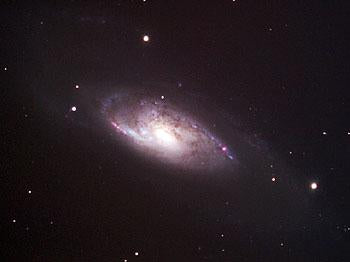
Advanced Telescopes
The most popular telescope design used for CCD imaging is the Schmidt-Cassegrain. This design offers a lot of versatility for both imaging and viewing. This fact as well as their portability and moderate price make them very popular instruments. However, many CCD imagers graduate to telescopes which are more specialized for specific types of imaging. Below are a few of the most popular telescope designs for advanced CCD imaging.
Apochromatic Refractors
For wide-field imaging it is hard to beat this design. Many refractors tend to have short focal lengths and fairly fast focal ratios, making them ideal for CCD imaging of large objects. However, only apochromatic refractors are really suited for high-resolution CCD imaging. Refractors which suffer from chromatic aberration will produce star images which are likely to be unacceptable to the advanced imager. Apochromatic refractors use special designs and advanced-technology optical components to reduce chromatic aberration. These telescopes are well-suited to CCD imaging.

Above: A CCD image taken with a 6" apochromatic refractor
A variety of manufacturers offer apo refractors. Some of the most well-respected names in the industry are Astro-Physics, Takahashi and TeleVue. Other high-quality manufacturers include Stellarvue, TEC, TMB, Vixen, and William Optics. The most common sizes range from 70mm to 100mm in aperture. The most obvious reason for the popularity of this size range is that apo refractors are very expensive, often costing $1000 an inch or more. But another reason is that these scopes are often used for wide-field imaging and the shorter focal length of these smaller instruments is ideal for that purpose. Small refractors perfectly compliment a larger, long-focal-length instrument that is used for narrow-field imaging.
Most modern apo refractors have fairly fast focal ratios--typically f/5 to f/7--making them well suited for CCD imaging. Also, focal reducers are usually available as an accessory, allowing speeds at fast as f/4 to be easily achieved.
While the best refractors will likely always be very expensive, several manufacturers have started producing inexpensive apo refractors that produce surprisingly good images, especially considering their price (less than $1000). While not in the same league as the more expensive refractors in terms of optical and mechanical quality, these new less expensive telescopes are becoming popular choices for imagers who want a smaller second scope to compliment their SCT.
Ritchey-Chrétien Telescopes
This design has become very popular lately for high-resolution CCD imaging. Many of the best images now being taken by amateur astronomers are done using this design, and the images rival those taken by professional instruments. For capturing detailed images of smaller objects such as galaxies, this design is ideal.
The Ritchey-Chrétien (RC) is similar to the common Schmidt-Cassegrain in layout except that it does not require a corrector lens. SCTs use spherical mirrors which are inexpensive to manufacture but suffer from spherical aberration. By using a corrector lens this aberration is reduced. However, commercial SCTs still suffer from off-axis aberrations such as coma that degrade the image, as well as slight chromatic aberration induced by the corrector lens. The RC, on the other hand, uses aspherical mirrors -- specifically, hyperboloid shaped -- to eliminate both spherical aberration and coma. And since there is no corrector lens, there is no chromatic aberration either. The only remaining aberration is off-axis astigmatism, which is considered a minor aberration by most imagers. Almost all modern professional telescopes, including the Hubble Space Telescope, are Ritchey-Chrétiens.
RCs also suffer from field-curvature (as do almost all Cassegrain-style scopes, including SCTs), which limits how large a CCD camera can be successfully used on them without additional corrective optics. An RC with a field corrector which eliminates field curvature and astigmatism can yield exquisite images over a very large-format CCD camera.

Above: A CCD image taken with a 12.5" Ritchey-Chrétien telescope
Again the drawback to the RC design is that the aspherical mirrors are much more difficult to make than the spherical mirrors of an SCT, therefore the cost is considerably higher, again around $1000 an inch or more. However, for the advanced imager who wants the best quality in a high-resolution system, the RC is one of the best choices.
Like the apochromatic refractors, less expensive variations on the RC are becoming available. Meade has begun producing a line of "Advanced Ritchey-Chrétien" telescopes which are actually modified Schmidt-Cassegrains. They do eliminate the off-axis coma associated with standard SCTs and the astigmatism inherent in RCs, but they are not true Ritcheys. They do provide a benefit to imagers who want an improvement over an SCT without the cost of an RC.

